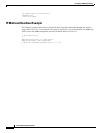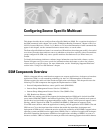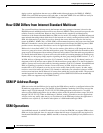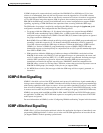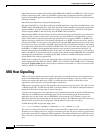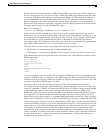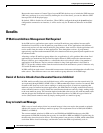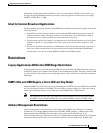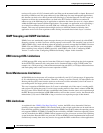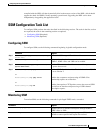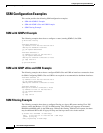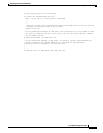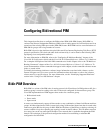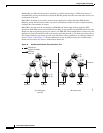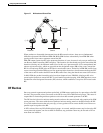
Configuring Source Specific Multicast
Restrictions
IPC-466
Cisco IOS IP Configuration Guide
receivers will receive all (S, G) channel traffic (and filter out the unwanted traffic on input). Because of
the ability of SSM to reuse the group addresses in the SSM range for many independent applications,
this situation can lead to less than expected traffic filtering in a switched network. For this reason it is
important to follow the recommendations set forth in the IETF drafts for SSM to use random IP
addresses out of the SSM range for an application to minimize the chance for reuse of a single address
within the SSM range between different applications. For example, an application service providing a
set of television channels should, even with SSM, use a different group for each television (S, G)
channel. This setup will guarantee that multiple receivers to different channels within the same
application service will never experience traffic aliasing in networks that include Layer 2 switches.
IGMP Snooping and CGMP Limitations
IGMPv3 uses new membership report messages that may not be recognized correctly by older IGMP
Snooping switches, in which case hosts will not properly receive traffic. This situation is not an issue if
URD or IGMP v3lite is used with hosts where the operating system is not upgraded for IGMPv3, because
IGMP v3lite and URD rely only on IGMPv1 or IGMPv2 membership reports. For more information
about switching issues related to IGMP (especially with CGMP), refer to the “Configuring IGMP
Version 3” section of the “Configuring IP Multicast Routing” chapter in this document.
URD Intercept URL Limitations
A URD intercept URL string must be fewer than 256 bytes in length, starting from the /path argument.
In the HTTP/TCP connection, this string must also be contained within a single TCP/IP packet. For
example, for a 256-byte string, a link maximum transmission unit (MTU) of 128 bytes between the host
and intercepting router would cause incorrect operation of URD.
State Maintenance Limitations
In PIM-SSM, the last hop router will continue to periodically send (S, G) join messages if appropriate
(S, G) subscriptions are on the interfaces. Therefore, as long as receivers send (S, G) subscriptions, the
shortest path tree (SPT) state from the receivers to the source will be maintained, even if the source is
not sending traffic for longer periods of time (or even never).
This case is opposite to PIM-SM, where (S, G) state is maintained only if the source is sending traffic
and receivers are joining the group. If a source stops sending traffic for more than 3 minutes in PIM-SM,
the (S, G) state will be deleted and only reestablished after packets from the source arrive again through
the RPT. Because no mechanism in PIM-SSM notifies a receiver that a source is active, the network must
maintain the (S, G) state in PIM-SSM as long as receivers are requesting receipt of that channel.
HSIL Limitations
As explained in the “IGMP v3lite Host Signalling” section, the HSIL tries to determine if the host
operating system supports IGMPv3. This check is made so that a single application can be used both on
hosts where the operating system has been upgraded to IGMPv3 and on hosts where the operating system
only supports IGMPv1 or IGMPv2. Checking for the availability of IGMPv3 in the host operating system
can only be made by the HSIL if IGMPv3 kernel support exists for at least one version of this operating
system at the time when the HSIL was provided. If such an IGMPv3 kernel implementation has become
available only recently, then users may need to also upgrade the HSIL on their hosts so that applications



